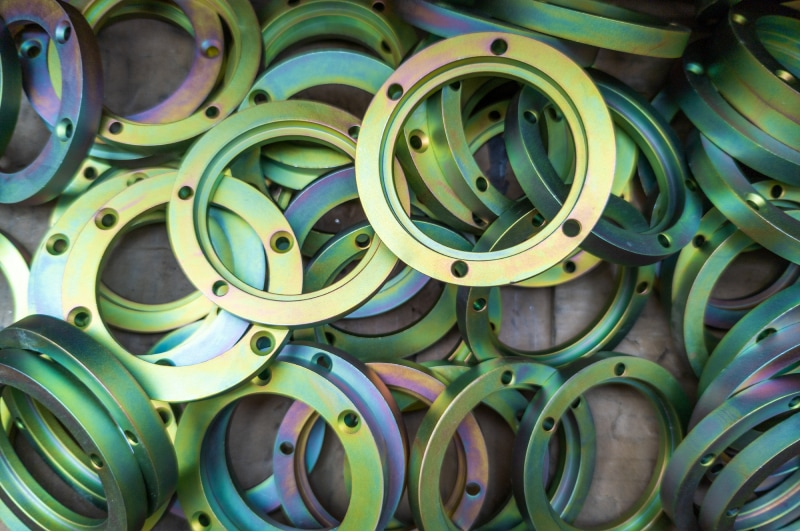3 Types of Electroplating For Commercial Use
The electro-deposition process is highly adaptable. Plating material options range from precious metals like silver and gold to industrial workhorses like zinc and cadmium.
When selecting electroplating for metal products, manufacturers must balance competing priorities: aesthetics, corrosion protection, cost, and durability all matter. Here are three types of electroplating we recommend for the lion’s share of commercial applications.
1. Cadmium Electroplating
Cadmium is not a plate you select for hardness, like nickel or chrome, but for its versatile, application-specific traits. Cadmium in its natural state is actually a rather soft, white metal with excellent lubricity, corrosion resistance, and conductivity. With the option to use cadmium chromate conversion coatings, it’s also easily customizable. Cadmium chromates trade the familiar gold hue of cad plating for other colors such as navy, black, or olive drab (popular in military applications).
So, why go with cadmium electroplating? Manufacturers and OEMs across the aerospace, military, mining, automotive, aviation, and industrial sectors all prize low material costs. Cad is not an expensive metal, but it yields a plate with outstanding resistance to rust, mold, bacteria, and galvanic corrosion from aluminum. At the same time, it’s highly malleable and solderable, with an exceptional bonding surface for adhesives.
These benefits suit it well for outdoor applications where salt spray, environmental moisture, and corrosive contaminants abound. Cadmium is a great “sacrificial plating” that improves the durability of the underlying product by offering itself up as a barrier that absorbs environmental wear and tear. Because it’s easily dyed, cad is a wonderful cosmetic choice and can act as the final finish or a great base for paint.
However, cadmium is also a known carcinogen that must abide by carefully regulated processes in metal finishing. It is not REACH or RoHS compliant, so certain restrictions do apply to cadmium plating.
2. Nickel Sulfamate Electroplating
This is the plate you select for resilience. Unlike with many other plates, it’s possible to deposit an unusually thick nickel sulfamate layer of up to an inch or more when an application calls for truly top-end toughness.
Nickel sulfamate plating offers a powerful combination of hardness and corrosion protection, but it also polishes to a beautiful sheen with its 99.9% pure nickel deposit. Sometimes nickel sulfamate is used as an undercoat for a top layer of chromium plating, in order to further boost the final corrosion resistance.
Since the sulfamate nickel plating process results in an anti-corrosion coating with an incredible 1400 C melting point, it’s reliable for high-heat industrial applications. Food service uses nickel plate on equipment that must survive ovens, abrasive forces, moisture, and bacteria. The easily machinable nickel layer provides both high tensile strength and excellent ductility, ensuring that the plated surface will withstand elongation without deformation or stress cracking.
These traits suit nickel perfectly to applications such as dimensional corrections on machined parts, the resurfacing of worn parts, and restoration of industrial process equipment. We have many customers who request nickel sulfamate for electroforming components (stamping tools, metal masks, resin molds, and the like). The corrosion and moisture resistance mixed with the long-term durability of nickel also make it superb for pipe cladding and plating chemical reaction vessels or storage tanks.
3. Zinc Electroplating
Zinc is an all-purpose workhorse that’s as cost-effective as it is environmentally friendly. We see zinc plate on plenty of common home goods like cutlery, bathroom fixtures, nuts, bolts, and fasteners. Manufacturers depend on high value and low cost zinc electroplating for benefits such as longer life cycle requirements, extended product warranties, and sustainable business practices.
Zinc is both durable, from a practical standpoint, and also versatile, with a finish that can range from a dull matte to a shiny and chrome-like. Pure zinc has up to half of the hardness of steel. Like with cad, zinc can be chromated or passivated in a variety of colors such as clear, blue, iridescent yellow, olive drab, and black. It resists corrosion fairly well, but when the application involves extremely corrosive environments, you may want to consider other types of electroplating that are targeted to provide maximum corrosion protection.
We see a lot of demand for zinc electroplating in heavy duty industrial or military equipment and small metal parts where low cost, light weight, and high durability are valued. It’s better suited for lower temperatures than nickel sulfamate, as zinc can degrade under high temperatures (unless specially treated for high-heat applications).
Finally, aerospace and other industries have begun to turn to zinc as a safer and more sustainable alternative to cadmium, which has toxic properties.
Do you need commercial plating services? Contact MFT today for any of these three types of electroplating from a team that prioritizes fast turnarounds and superior service.

